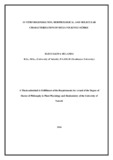| dc.description.abstract | Melia volkensii Gürke (Meliaceae; mahogany family), is a drought-tolerant, multipurpose, fast-growing, hardwood tree species endemic to East Africa’s arid and semi-arid lands. Utilization of its huge economic, ecological and biodiversity value is constrained by difficulties in propagation via seed and vegetative methods. Alternative propagation via tissue culture has received little attention. This study investigated high-frequency regeneration of the species through tissue culture and assessed the extent of morphological and genetic similarity between tissue-cultured and normal seedlings of same parent trees. Callus induction and regeneration potentials of ten explant types were investigated using Murashige and Skoog (MS) and Gamborg’s B5 media containing 0.05 – 4 mg/l of the cytokinins 6-Furfurylaminopurine (Kinetin), 6-Benzyl-aminopurine (BAP) and 1-Phenyl-3-(1,2,3-thiadiazol-5-yl)urea [TDZ]). Modes of regeneration were studied morphologically and histologically. Influences of polyethylene glycol (PEG) and amino acids on regeneration response were also investigated, as were the effects of type and concentration of plant growth regulators on shoot elongation and rooting. Morphological characterization used morphometric and meristic traits while genetic characterization used random amplified polymorphic DNA (RAPD) molecular markers. Extents of morphological and genetic similarity were asessed using multivariate analysis involving principal coordinate analysis, cluster analysis, analysis of similarities (Anosim) and similarity percentages analysis (SIMPER). Cotyledons and zygotic embryos were the most suitable explants, with 100% regeneration frequency. Regeneration was indirect (callogenic) in zygotic embryos but direct (non-callogenic) in cotyledons.The best medium for callus induction and regeneration from zygotic embryos was ½ MS + 0.05mg/l TDZ. That for direct regeneration in cotyledons was ½ MS + 0.25 mg/l TDZ. Presence of 20 or 30% (m/v) polyethylene glycol-6000 in medium had beneficial effect on regeneration in zygotic embryos but not in cotyledons. In zygotic embryos, 50 or 100 mg/l of L-glutamine and L-tryptophan significantly enhanced (p<0.001) somatic embryo induction and shoot regeneration. In cotyledons, 50 or 100 mg/l of L-tryptophan and L-proline had no significant increase in the percent of explants with somatic embryos but significantly enhanced (p<0.001) the percent of explants with shoots. Optimal elongation of microshoots occurred in ½ MS + 0.1 mg/l BAP + 0.01 mg/l IAA. The best rooting occurred in ½ MS + 0.1 mg/l NAA + 0.1 mg/l IBA. Unconventional, low-cost agrochemical TDZ gave a high efficacy of regeneration (100%), outperforming both BAP (76%) and Kinetin (36%). The maximum mean yield of transplantable shoots obtained using TDZ was 12 shoots per explant. Phenotypically normal shoots of 3 to 6 cm height were obtained within 3.5 to 4 months and successfully acclimatized and transferred to soil. Regenerants had significantly reduced (p<0.05) taproot length, internode length, shoot height and number of lateral roots in comparison with normal seedlings. However, RAPD markers showed high genetic similarity between regenerants and their parents, with an overall average genetic similarity estimate of 85.32%. This indicates that observed morphological differences could be epigenetic or physiological. Cotyledons gave plants that were morphologically and genetically closer to the normal seedlings than those from zygotic embryos. These findings are the first indication of close genetic proximity between tissue-cultured M. volkensii and parent trees. The study also offers two new, simple and highly reproducible protocols for regeneration of M. volkensii plants. These could be applied in large scale in vitro cloning of elite M. volkensii mother trees for germplasm conservation and commercial forestry for supply of hardwood timber and botanical pesticides. | en_US |



